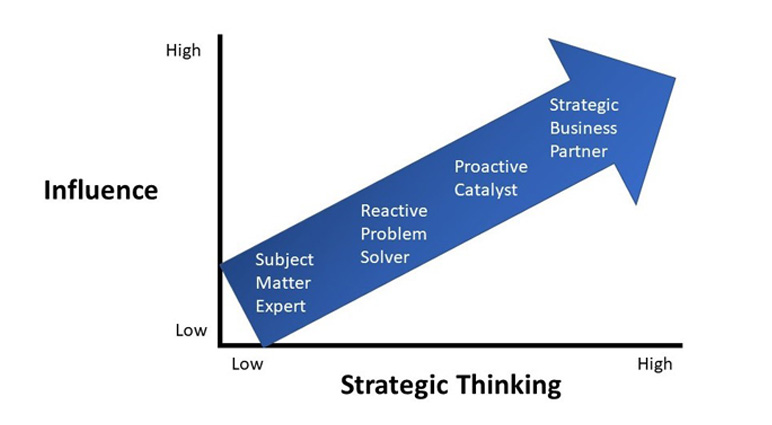The Actuary’s Journey to Becoming a Strategic Business Partner
By Michael Seitchik and Barbara Taylor
Stepping Stone, January 2021

As business uncertainty and risk increase, technical and analytical skills are becoming "table stakes" for actuaries, and other skills are needed for those who want to gain influence and get beyond the narrow box they are often put in by others.
How do you escape the trap of being perceived as competent in only a narrow area? How do you as an actuary gain more influence and provide the value you know you could provide? How do you become a true business partner to senior line executives?
Well, it takes time to be perceived as a strategic business partner. But you can take actions to speed your journey.
THE JOURNEY FROM SUBJECT MATTER EXPERT TO STRATEGIC BUSINESS PARTNER
You just can’t pronounce yourself a strategic business partner. Unlike being a subject matter expert (SME) in actuarial issues, which is task or knowledge focused, being a business partner is relationship focused. It is a relationship that is earned. You must earn others’ trust. You must earn their confidence.
You earn it by steadily increasing the value you bring to executives (Figure 1).
Figure 1
The Relationship Between Strategic Thinking and Influence
While the path is not always strictly linear, there are some milestones that can help you successfully navigate the journey.
- Subject Matter Expert (SME)
Just because being an SME is at the beginning of the journey does not mean it isn’t a valuable position. Being an expert actuary is valuable. However, your power and influence are very limited. SMEs are often viewed as only being competent in a very narrow set of skills or knowledge and are often not “invited to the table” to participate in decision making.
- Reactive Problem Solver
The next step in the journey is being asked to solve a problem. That is, you are now invited to the table, but only to help solve a specific actuarial problem. Now you are no longer just providing specific information, but helping others solve problems. You add value by providing solutions, not just technical information or advice.
Others are beginning to trust you a little more, but your influence is still primarily an outcome of subject matter expertise and not a trusting relationship.
- Proactive Catalyst
A proactive catalyst also provides options. But, unlike reactive problem solvers who react to problems to provide solutions, catalysts proactively suggest new ideas. You are providing insights that go beyond the problem as others have defined it. You are anticipating issues that executives have not even considered yet. Others now feel you are interested in making them and the business successful and not just in showing how much you know.
As a result, you are perceived as less of a risk. You are building a relationship on trust, and not just your expertise.
In essence, you are a great consultant—a highly valuable resource who can think strategically and systemically. You now have influence over what issues are discussed as well as how to reduce risk.
- Strategic Business Partner
Finally, you are a partner when others trust you so much, they let you in on their concerns. They reveal or disclose their uncertainties. Now you are being invited to help an executive deal with what they perceive as their biggest risks and not just typical actuarial issues. Your role is to help them think about alternatives and to give them confidence in their decisions. You now have the most influence. You are like their personal coach or right-hand person. You are helping them with the classic “what keeps them up at night” issues.
You have now made the transition to a relationship based on trust and the ability to help them solve their deepest risk issues. You now have a significant amount of influence. You are part of the executive team.
Of course, not every relationship is going to be that of a strategic business partner. That is unrealistic. But to be perceived as someone who adds value, you should consider how to shift to reactive problem solver or, even better, a proactive catalyst.
ESCAPING THE TRAP
You can escape the trap of being perceived only as an SME or vendor. However, it takes time to build a more trusting relationship. Remember, there are times the other party only wants a subject matter expert. Or, what they really want or are ready for is a catalyst. The point is that you cannot force or dictate your role. It is based on a relationship that depends on your skills and their needs. You can work on the former, but you can’t control the latter.
“THINK MORE STRATEGICALLY”
We find that executives often tell middle managers or SMEs, “You should think more strategically!” However, the executive never defines what they mean by “thinking more strategically.”
In that case, it is suggested you use the strategic thinking model presented in Figure 1 to begin a conversation with that person to define exactly what they mean by thinking more strategically. Or, ask them, “What would it look like if I were more strategic with regards to this upcoming project?” Help them describe the behaviors they are looking for.
Thinking more strategically is the key to advancing on the journey to becoming a proactive catalyst or valued business partner.
Watch for part 2 of this series, where Michael and Barbara will describe specific actions you can take as an actuary to navigate the journey to becoming an actuarial strategic business partner.
Statements of fact and opinions expressed herein are those of the individual authors and are not necessarily those of the Society of Actuaries or the respective authors’ employers.
Michael Seitchik is the founder of Michael Seitchik LLC, a firm specializing in executive coaching and change management. He consults on a number of topics including leadership development, implementing change, strategy development and execution, influence skills, constructive conflict and creating mutually accountable teams. He can be reached at michael@michaelseitchik.com.
Barbara Taylor is a business partner at Janbara & Associates and cofounder of Silo-Busting Networking. She coaches executives and designs creative leadership development programs. Barbara is Beacon’s Membership Committee Chair. She can be reached at btaylor@janbara.com.

